It’s not easy for a game to stand the test of time. As technology evolves and the scope of knowledge in the world grows, so too do our expectations. Even the most innovative games’ popularity will generally dwindle over time, as newer releases build on their predecessors’ successes to bring a better, fresher experience to the table. However, a select few–games like Tetris, Scrabble, and Chess–are so pure and perfected in the fundamentals of their gameplay that they’re essentially timeless in their appeal, and have maintained their popularity over the years as a result. Magic: The Gathering is an example of such a game.
This year marks the 30th anniversary of the release of the original trading card game. And it’s not just still around on the fringes of society; it has boomed in popularity in recent years. With a string of well-received new card sets, the post-COVID return of high-level competitive play, and the release of an incredibly user-friendly new digital client, there has never been a better time to get into MTG.
That said, getting your feet wet in the game can be an intimidating endeavor at the start. There have been over 20,000 unique Magic cards printed since its inception in 1993. It’s a complicated game, to be sure, with an incredible level of depth to its strategy. There have even been full-length books written on how to use a single card! Even Hall of Fame players and pros would surely tell you that they’re never done learning, and that there’s always room to improve.

However, if you’re willing to take the plunge, you might just discover the most rewarding, endlessly replayable gaming experience of your life. Here’s where to start. Welcome to Magic: The Gathering.
What is Magic: The Gathering?
When Magic: The Gathering, created by game designer Richard Garfield, was first unveiled at Gen Con in ’93, it was an immediate success. The concept–cards of varying rarities, randomly assorted in “booster packs,” that can be played with in near-limitless combinations– was revolutionary at the time. Without Magic, the Hearthstones, Pokemons, and Yu-Gi-Ohs! of the world would look a whole lot different, and might not exist at all.
In Magic, you take on the role of a “Planeswalker”–a powerful mage, capable of traversing the many “planes,” or dimensions, of the Multiverse (the fictional universe where the Magic story takes place). To defeat your opponent, a fellow Planeswalker, you must cast spells and summon creatures powerful enough to outmatch theirs.

Contrary to popular belief, Magic is not a tabletop RPG like Dungeons & Dragons (though both games are owned by Wizards of the Coast). There may be plenty of elves, dragons, and sorcery at play, but where D&D is all about imagination and teamwork, Magic is a cutthroat, competitive card game through and through.
The gameplay and strategy of Magic is are frequently described as a combination of poker and chess. Like poker, variance and hidden information are both central to the game, so some knowledge of statistics, bluffing, and concepts like “expected value” is key to success. And like chess, there are near-infinite different ways any given game can play out, so thinking a few turns ahead, and having a plan for how to take down your opponent, are both crucial skills.
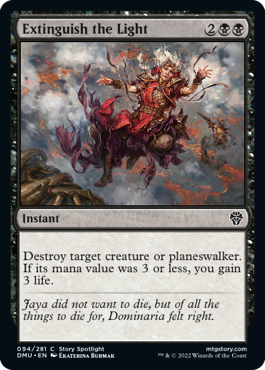
As for the story, it’s been being continuously written for the past 30 years, so the lore is incredibly deep and complicated by this point. It follows a handful of recurring Planeswalker characters as they traverse the many worlds of the Multiverse–fighting wars, saving civilizations, making and breaking allegiances… the typical fantasy goodness. Whenever a new major set of cards is released (which happens about four times a year), the story is expanded upon, with the backdrop of whatever particular plane that set takes place in.
You can piece together what’s going on just by looking at the art and reading “flavor text” (short, italicized story blurbs you’ll find printed on some cards). Or, if you’re the type to get deep into lore, you can check out the regularly released, free-to-read story content published by Wizards of the Coast. Luckily, you don’t need to know anything about the story to start playing, so the amount you chose to engage with that side of the game is entirely up to you.
The Rules
Learning the rules of Magic: The Gathering is the part of the process that all too often scares new players away. The official comprehensive rulebook for the game is almost 300 pages long, after all! Needless to say, what follows is not an exhaustive explanation. But don’t think you need to know every single corner case and minutia before playing your first game. Understanding the basics is all you need to get started; the rest comes naturally with time and practice.
The Basics
In a typical 1v1 game of Magic, each player starts at 20 life with seven cards in hand, drawn from their respective decks (there are exceptions, which we’ll get to in the “Formats” section). After rolling a die to see who goes first, players then take turns, drawing one card from their deck at the start of each of their turns. The first player to get their opponent’s life total to zero wins the game.
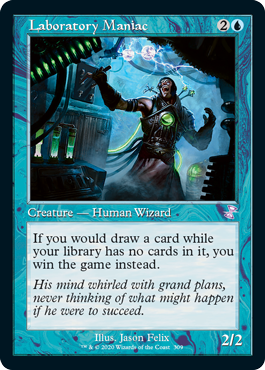
Sounds simple, right? Well, it basically is! Where it gets more complicated is in the specifics of the cards themselves, how they function, and how they interact with each other. To understand what the process of winning a game of magic actually looks like, let’s take a look at the different types of cards.
Card Types
There are seven main different card types in Magic: The Gathering, which you’ll find noted underneath the art on every card. There are two different classes of card types: “Permanents” and “non-permanents.” Permanent cards stay on the battlefield after you play them, whereas non-permanents have a one-time effect, after which the card goes to your graveyard.
We’ll start with the permanents.
Lands
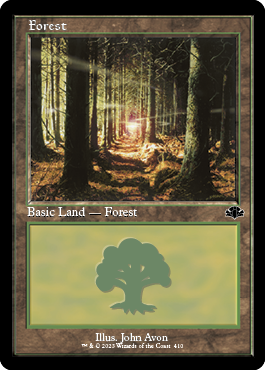
Lands are arguably the most important card type in Magic. They’re how you pay for the spells you cast, so without them, the rest of the cards in your deck are useless. For this reason, most decks will consist of between 40-45% lands; you want to have a few in your opening seven-card hand to ensure you’ll be able to play out the rest of your cards.

Your lands pay for your spells by providing a magical energy source, known as “mana.” The mana cost of any card is listed in the top right corner. (Grizzly Bears, for example, costs one green mana, plus another mana of any color).
The specific color of mana added by your lands depends on the type of land (“Plains” tap for white mana, “Islands” for blue, “Swamps” for black, “Mountains” for red, and “Forests” for green). To add mana, you must turn your land sideways. This action is known as “tapping.” You’ll see it represented by a circular right arrow symbol on cards. Your permanents stay tapped until the beginning of your next turn, so once you tap a land for mana, you can’t use it again until your next turn.
In a game of Magic, you can play one land card per turn. Since they’re permanent cards, they’ll stay on your side of the battlefield for the duration of the game once you play them. So, the later into a game you get, the more expensive cards you’ll be able to cast. On turn one, you’ll only have one land in play, so you can only play something that costs one mana. But if you’ve managed to play a land every turn by turn five, you can play something that costs five. Getting there is no guarantee, however; not drawing enough lands, and therefore being unable to play your spells, is referred to as getting “mana screwed”–a common complaint you’ll hear from salty players. As we noted at the top, variance is a big part of the game.

The basic lands–Plains, Islands, Swamps, Mountains, and Forests–all only tap for the one color that they produce. Non-basic lands, however, can often tap for two or more different colors of mana. Lands like this typically come with some sort of drawback. Dimir Guildgate, for example, enters the battlefield tapped, so you can’t use it until the following turn.
Creatures
After lands, creatures are the next most important card type in Magic: The Gathering. Attacking with creatures is the simplest, and most common way of getting your opponent’s life total from 20 to zero.

Once per turn, during your “combat phase,” you can attack with any number of your creatures. The amount of damage that a creature deals and the amount of damage that it can take before dying are each determined by its “power” and “toughness.” These stats are listed on the bottom right corner of any creature card. Armored Warhorse, for example, has 2 power, and 3 toughness. So if you land a hit on your opponent with it, their life total will drop by 2.
However, if your opponent has creatures of their own, they will have the option to block your attacking creatures. Blocking prevents all damage to your opponent, regardless of the relative size of the creatures in combat. A 1/1 creature can block a 10/10 creature and still prevent all damage to the defending player, for example.
When a creature blocks an attacking creature, they will both simultaneously deal damage equal their own power to the other creature’s toughness. So, if a 2/2 creature blocks another 2/2, they will both take 2 points of damage and die. But if a 2/3 blocks a 2/3, both creatures will only take 2 damage to their 3 toughness, and therefore survive. (Damage dealt to creatures wears off at the end of each turn).

Just like adding mana with your lands, attacking with a creature requires tapping it. A tapped creature cannot block, so when you decide to attack with a creature, you know you won’t be able to block your opponent’s creatures with it on their turn. Some creatures, such as Soulmender, have non-attack abilities that require tapping, so it’s up to you whether you want to attack your opponent or use your creatures’ abilities.
However, whenever a creature enters your side of the battlefield, it will have what’s known as “Summoning Sickness” until your next turn. (Think of it as being a bit wobbly and disoriented, having just been cast into existence by a sorcerer and all). Being Summoning Sick simply means being unable to tap. So when you cast a creature, you’ll still be able to block your opponent’s attacking creatures on their following turn, but you won’t be able to do any attacking or ability-activating of your own until your next turn.
Enchantments
Next up are enchantments. Being permanents, enchantments will sit on the battlefield indefinitely once you cast them, unless removed by some other effect.
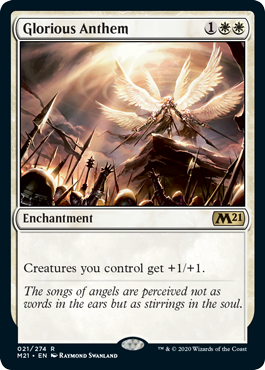
Many enchantments will sit on your side of the battlefield, and offer any number of positive effects to you in the game. Glorious Anthem, for example, grants a +1/+1 buff to all your creatures, making your 2/2 cards into 3/3 cards, and so on.
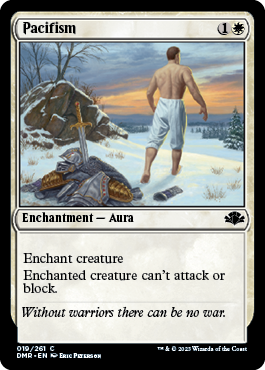
Then there’s the enchantment subtype known as “Auras.” These enchantments target specific creatures on the battlefield. Some, such as Pacifism, have a negative effect, and are meant to be cast on your opponent’s creatures. There are also Auras that can be used to make your own creatures better, by increasing their power and toughness or granting some other type of ability.

Some enchantments, such as Eidolon of Inspiration, are also creatures, and count as both card types. All the same rules around creatures apply.
Artifacts
Artifacts tend to function a lot like enchantments: They stick around on your side of the battlefield, and give you some sort of positive effect.

A common theme among artifact cards is mana production. Manalith, for example, taps to add a mana, just like a land. So if you play it on turn three, and play a land on turn four, you’ll have access to five total mana, instead of just four. (Playing cards that increase your mana production is called “mana ramp”).
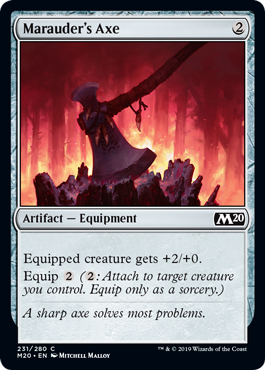
Similar to enchantment auras, artifacts have a common subtype of their own, known as “Equipment.” Think of these as weapons on your side of the battlefield that can be used to buff your creatures. Marauder’s Axe, for example, increases your equipped creature’s power by 2. Unlike auras, equipment cards can be moved around your creatures as you please, by paying the “Equip cost” (two mana of any color, in the case of Marauder’s Axe).

Like enchantments, you’ll commonly run into creatures that are also artifacts. Some of them, such as Chief of the Foundry, will benefit you for playing as many artifact creatures as possible. (You’ll hear cards like this referred to as “synergy cards”).
Planeswalkers
The last permanent card type to cover is Planeswalkers. Think of these as another player on your side of the battlefield, working alongside you to help take your opponent down.
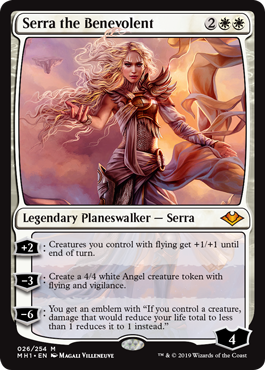
Many Planeswalkers’ last ability will require removing many loyalty counters, to give some massive, game-winning effect. This often comes in the form of an “emblem”–a permanent effect on the rest of the game. In the case of Serra, it makes you essentially un-killable as long as you control a creature.
Just like players, Planeswalkers can be attacked by opposing creatures. When a Planeswalker is dealt damage by creatures (or any other effect), it loses that many loyalty counters. Planeswalkers with zero loyalty counters go straight to your graveyard. Players can choose to send some number of their attacking creatures at an opposing Planeswalker, and others at the player. Attacking and blocking rules remain the same.
That’s it for permanents! Now, for the two non-permanent card types.
Sorceries
Any non-land card you play in Magic is considered a “spell.” But sorceries are the real spells of the game in a traditional sense: They are cast for a one-time effect–for your benefit and/or your opponent’s detriment–before the card goes to your graveyard, having done its job.
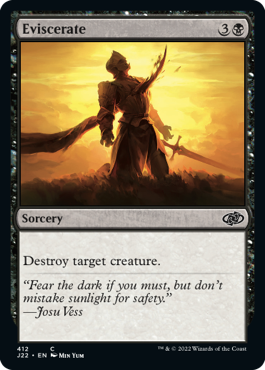
Sorceries come in all different varieties, and can have any number of unique effects. One of the more important types of effects in the game is known as “removal spells”–cards that destroy opposing creatures. Eviscerate is an example of such a sorcery.
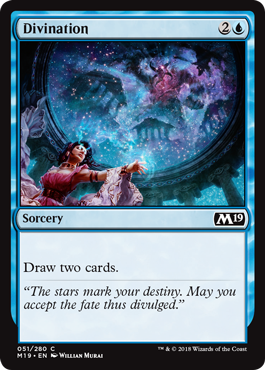
Other sorceries are less about affecting the battlefield, and more about getting you up on resources. Cards, being the most important resource in the game, are something you can always use more of. Divination gains you this advantage by drawing you cards.

There’s no end to the types of different effects that sorceries can have in a game of Magic–everything from taking extra turns, to gaining control of an opponent’s creature, to searching up cards in your library (Demonic Tutor being the most iconic example of such a card). It all comes down to mana cost, rarity, and color–more on that below.
Instants
Instants are just like sorceries, except for one key difference: Unlike every other card type we’ve covered thus far, it doesn’t need to be your turn to cast one. Instants can be cast at any time–even during your opponent’s turn.
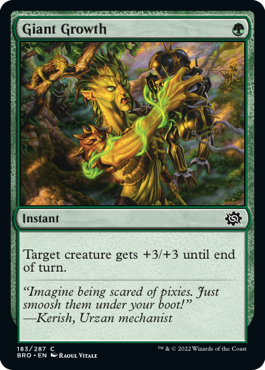
This is important in a number of different ways. Giant Growth, for example, increases one of your creature’s power and toughness. So, your opponent might attack you with their 4/4 creature during their turn. You block with your 2/2, cast Giant Growth, and suddenly your creature is a 5/5. Your creature survives, and theirs dies. (Cards like this are known as “combat tricks”).
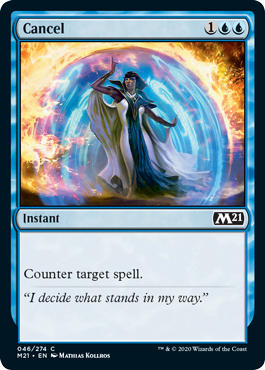
Another common type of instant is known as “counter spells”. When a spell is countered, it goes straight to the graveyard, rather than entering the battlefield if it’s a permanent, or applying its effect if it’s a non-permanent. So, if your opponent casts something during their turn, and you respond by casting Cancel, you will have entirely negated their play.
Like sorceries, there’s a near-limitless number of effects that an instant can have. But having the option of casting them at any point opens up a whole world of strategy. Instants are why bluffing exists in Magic, for example.
The Golden Rule
We’ve laid out the basics of how a game of Magic works, and how the different types of cards function and interact. However, as you go forth and continue learning and getting a lay of the land, it’s important to remember one of the “Golden Rules” of Magic: The Gathering. As stated in the official rulebook:
“Whenever a card’s text directly contradicts [the] rules, the card takes precedence…”
This fundamental is at the heart of what makes Magic such a vast game, with near-infinite new situations to discover and problems to solve. The rules themselves are fairly simple; it’s the cards that break these rules that open up endless possibilities.
A few examples:
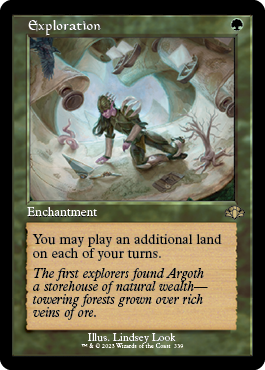
The rules state that you may play one land per turn. But with Exploration in play, you may play two.

Each player draws one card at the start of their turn. But with Howling Mine in play, each player draws two cards instead.
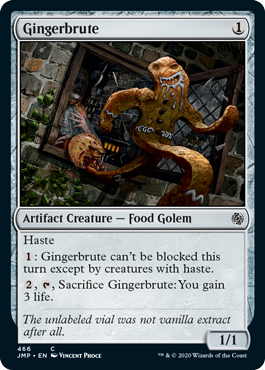
A creature has summoning sickness the turn it’s played. But a creature with “haste” is unaffected by summoning sickness, and is able to attack and tap for abilities as soon as it enters the battlefield.
There are countless exceptions to the rules like these–far too many to list here! The best way to discover them is to start playing. Soon, the card effects and creature abilities that alter the fundamentals of the game will become second nature.
Colors
The five different colors in Magic: The Gathering are central to both the gameplay and flavor of the game.
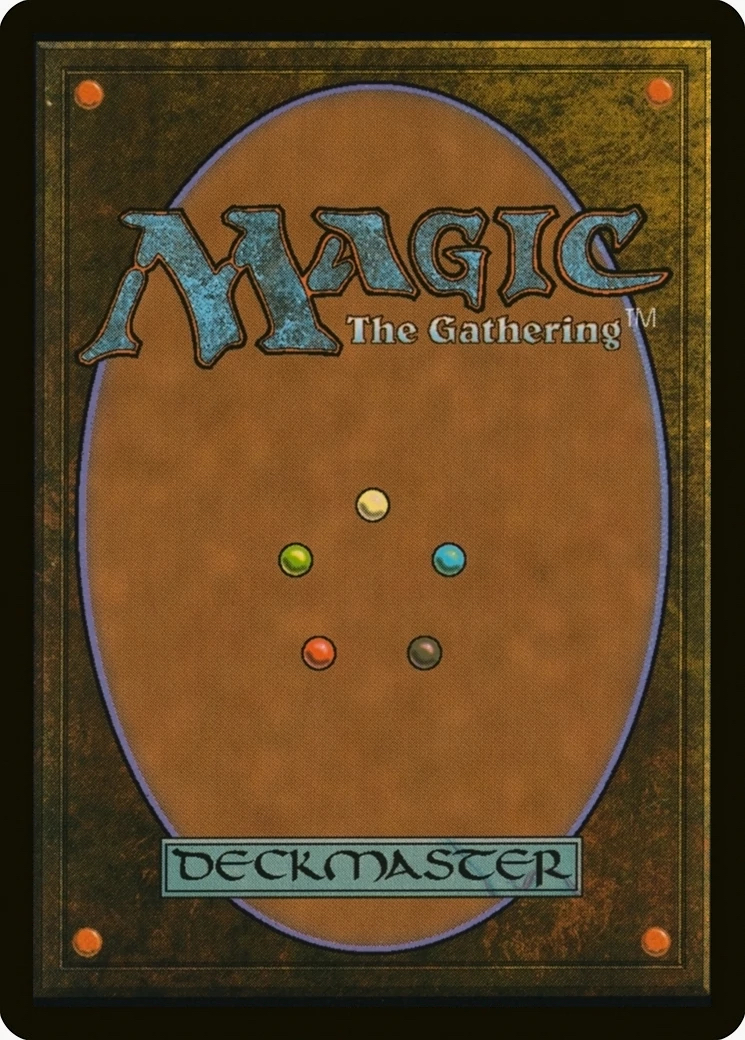
If you look at the back of any Magic card printed from its inception, you’ll see what’s known as the “color pie”: white, blue, black, red, and green (or “WUBRG,” as it’s known), in that order. Each color is most closely related to the two adjacent colors (known as “allied colors”), and most at odds with the two across (known as “enemy colors”).
Each color in Magic has its own distinct identity, strengths and weaknesses, strategic overtones, and recurring mechanics. Whenever a new set comes out, the whole picture of each color might shift and evolve somewhat, but the colors’ core philosophies have generally stayed consistent over the years. What follows is a brief description of each. For a full picture, including a complete list of mechanics in each color, check out head Magic designer Mark Rosewater’s article, Mechanical Color Pie 2021.
White
White is all about law and order, peace, and fairness. In their view, the path to morality and righteousness is clearly defined, and not to be strayed from at any cost.
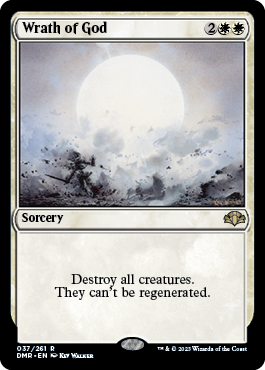
Some common White strategies include life gain, swarming the battlefield with an army of small creatures, and symmetrical effects on the game (they are obsessed with fairness, after all). Wrath of God is a classic example of such a card.
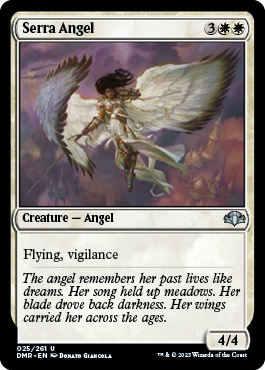
Common White creature types include Humans, Soldiers, and Angels. The most common creature abilities you’ll see in White include “vigilance” (creatures with vigilance don’t tap when they attack), “lifelink” (when a creature with lifelink deals damage, its controller gains that much life), and “flying” (creatures with flying can’t be blocked except by creatures with flying or “reach”).
Blue
Blue is the color of logic, trickery, and the accumulation of knowledge. They seek to understand the world and all the mysteries hidden within it.
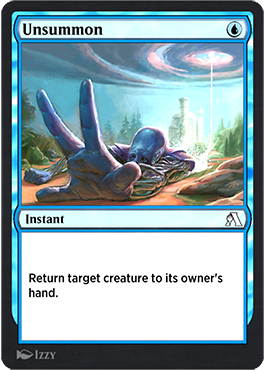
Given their emphasis on knowledge, card draw is a common theme you’ll find on blue cards. The color is well suited for controlling strategies; blue decks will often function largely at instant speed, playing nothing on their own turns, and waiting for the opponent’s turn to counter their spells and gain card advantage. “Bounce spells”–cards that return cards to their owner’s hand–are another common effect in blue.
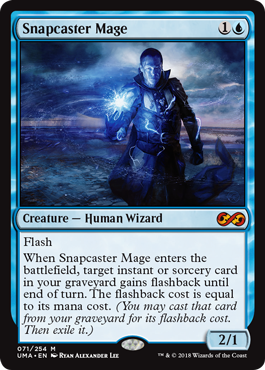
Blue creature types include Merfolk, Wizards, and Spirits. Blue creatures often have flying, as well as occasionally “flash” (creatures with flash can be cast at instant speed).
Black
Black is–you guessed it–the most evil color in Magic. Their philosophy is summed up by individualism, manipulation, and sacrifice.
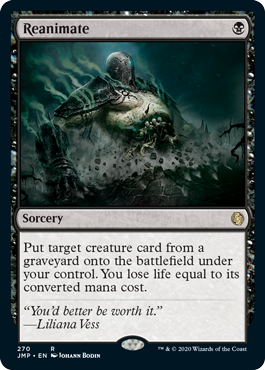
Black strategies often revolve around forcing opponents to discard cards, sacrificing your own creatures for a benefit, and using your graveyard to your advantage. Cards that bring creatures back from the graveyard to the battlefield, such as Reanimate, are a particularly iconic, powerful Black strategy. Black also gets the most cards that destroy opposing creatures, so most Black decks will have plenty of cards that do just that.
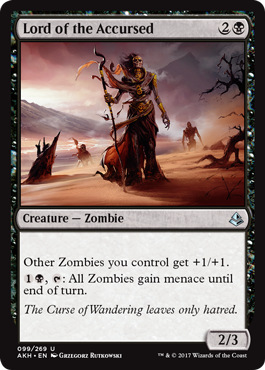
Common Black creature types include Zombies, Vampires, and Demons. Common Black creature abilities include lifelink, “menace” (creatures with menace can’t be blocked by fewer than two creatures), and “deathtouch” (any amount of damage dealt to an opposing creature by a creature with deathtouch is enough to kill it).
Red
Red is the most unpredictable and chaotic of all five colors in Magic. They are all about freedom, self-expression, and emotion. And, of course… fire.
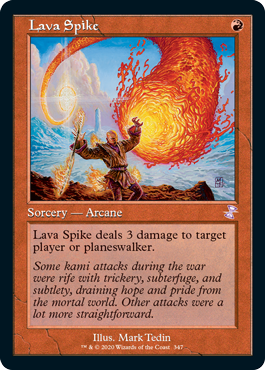
Red is without a doubt the most aggressive color in the game. A common Red strategy that’s been around since the beginning is known as “burn.” These decks are single-mindedly interested in getting the opponent’s life total to zero, with cheap, aggressive creatures, and burn spells, such as Lava Spike. Red decks can also use their burn spells to kill opposing creatures, to clear the way to larger threats later in the game.
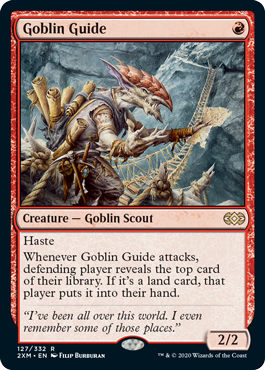
Goblins, Barbarians, and Phoenixes are common Red creature types. Haste, menace, and “first strike” (creatures with first strike deal damage combat before creatures without first strike) are the most common Red creature abilities.
Green
Last is Green. Green’s philosophy is centered around nature, growth, and abundance. More than any other color, mana is at the heart of what Green is all about.
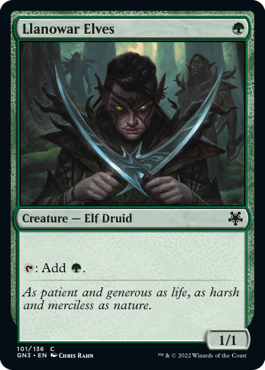
Mana ramp is one of the most common strategies you’ll find in Green decks. The game plan is fairly straightforward, yet effective: Play cards that accelerate your mana–be it with cards that search up lands from your deck, or “mana dork” creatures like Llanowar Elves–and play a giant monster ahead of schedule. Green’s creatures tend to have the best power/toughness-to-mana cost ratio of all the colors, so some Green decks prefer to simply cast an army of cheap-yet-beefy creatures and employ a more aggressively slanted strategy.

Common Green creature types include Elves, Centaurs, and all types of beasts. Reach, deathtouch, and “trample” (attacking creature with trample deal excess combat damage to defending player), are the most common abilities.
Multicolored
While each individual color in Magic has its own identity, that doesn’t mean you’re bound to playing only one color at a time. Most Magic decks, in fact, include two or more colors. Finding the unique ways that each color interacts with the others is a huge part of the fun of deck-building.
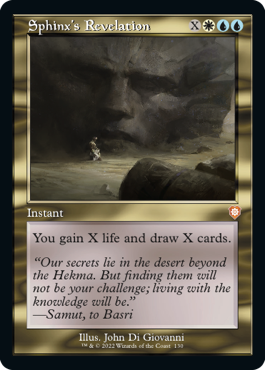
As noted earlier, the “allied” colors tend to work fairly well together naturally. White’s life-gain and symmetrical board effects pair nicely with Blue’s card draw and counter spells, for example, while Red and Black’s similarly sadistic core philosophies are a match made in heaven.
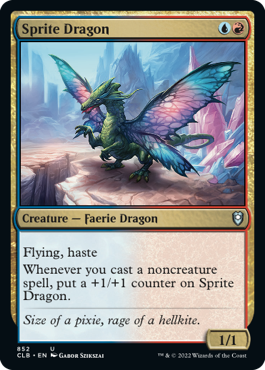
However, pairing together two “enemy” colors can lead to just as viable a strategy. Black and Green can work together to use the graveyard and mana ramp in conjunction to devastating effect, while Blue and Red can assemble a critical mass of non-creature spells with cards like Sprite Dragon to defeat the opponent in short order.
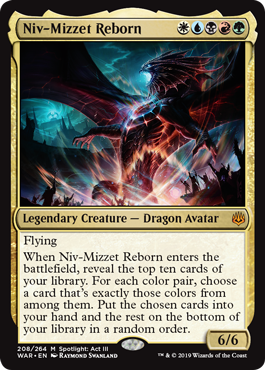
There’s no limit to what colors can go together in Magic. Putting all five colors together in a single deck can even be a viable strategy, so long as you have the mana base to support it! Experiment with all the different combinations to find which combinations’ strategies click most with your particular style of play.
Types of Decks
While there’s a near-infinite combination of different cards that can be combined in Magic to game-winning effect, overall strategies can be broken down into four different types of decks:
Aggro
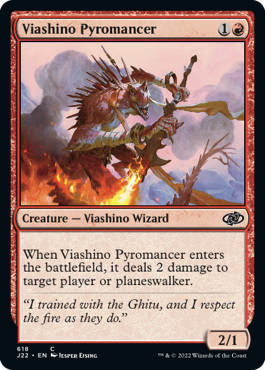
Aggro decks care about one thing, and one thing only: Getting your opponent’s life total to zero, as quickly as possible. This is typically done with a critical mass of cheap, efficient, aggressively slanted creatures, alongside a slew of removal spells to help clear out blockers, and maybe a few burn spells to seal the deal. Aggro decks often need fewer than average lands in their decks, since the rest of their spells tend to be so cheap. There have been winning aggro decks in every color in Magic, but Red and White are the most common.
Midrange

Midrange is just what it sounds like: A healthy mix of versatile, flexible effects that can serve as either aggressive or defensive, depending on the texture of a given game. Unlike aggro decks, midrange decks are less concerned about how quickly they can kill their opponent, and more with having the tools at their disposal to handle any type of situation. They can take their time whittling away at their opponent’s life total since they have the resources to play a long game if necessary. Most decks you’ll run into in Magic will be some shade of midrange. Any combination of colors can function as a midrange deck.
Control
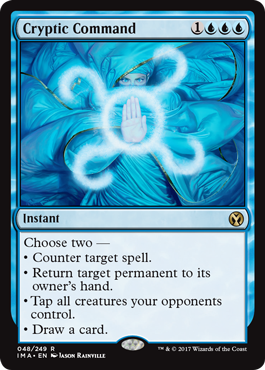
On the opposite end of the spectrum is control decks. Control decks want the game to go long. A typical control play pattern is to spend the first handful of turns countering the opponent’s spells, removing their creatures from play, and drawing some cards, before eventually running your opponent out of resources and cinching victory with a game-winning finisher. Control decks are all about inevitability; speed is the least concern when you know you have the long-game locked up. The vast majority of control decks are Blue, frequently paired with either White or Black.
Combo
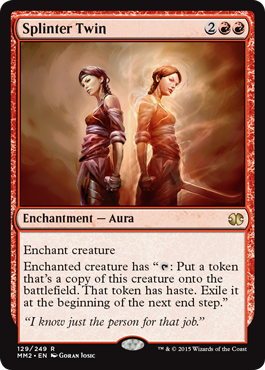
Combo decks are their own type of beast entirely. These decks are looking to assemble some combination of cards whose interaction essentially breaks the rules of the game. The rest of the deck is generally geared toward finding the necessary pieces, and protecting the combo once assembled.

A classic example of such a deck is the infamous Splinter Twin combo. Splinter Twin is an enchantment aura that lets enchanted creature tap to make a token copy of itself with haste. The creature Pestermite can untap a permanent when it enters the battlefield. So, throw a Splinter Twin on a Pestermite, and when the token copy enters, you can untap the enchanted Pestermite to make infinite copies of Pestermite with haste. An instant win.
Not all combo decks are quite so straightforward; many require many more moving pieces than just two cards to “go off.” However, playing against a good combo deck is one of the more fear-inducing experiences in Magic.
Formats
So, you know the card types, colors, and types of decks available in Magic: The Gathering. Now, how do you build a deck? What cards are available to choose from?
Well, that depend on the type of format you choose to play! The particular format dictates the list of cards legal to play with, as well as rules regarding deck construction and gameplay. We can’t cover them all here–there are over 20 official formats, plus even more created by fans–but you can find a full list with descriptions at Wizard of the Coast’s website.
There are two main types of formats in Magic: Limited, and constructed. We’ll start with constructed.
Constructed
Constructed is any format where you come to the game with a deck built ahead of time. These decks are generally (but not always) 60 cards, with roughly 24 of those being land cards. You are limited to four copies of any one card in your deck, with the exception of basic lands.

The card pool you have access to for building your constructed deck depends on the specific constructed format that you’re playing. In Standard, one of the most popular constructed formats, you’re limited to only cards from the most recent round of sets that have been released. When the fall set is released each year, the four oldest sets legal in Standard rotate out. With the format in such a perpetual state of flux, the “metagame” is ever-evolving, so you need to stay on top of updating your decks with new cards as a result.
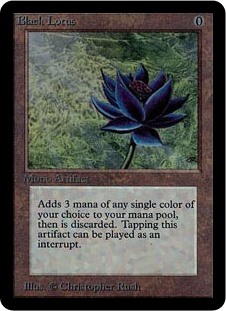
Other constructed formats, however, have a much wider range of cards legal to play with. In Modern, for example, most cards printed since 2003 are fair game. With so many more cards to choose from, the power level of the format is much higher than something like Standard. The ultimate example of this is with Vintage, where every card printed since the very first set (with a few exceptions) is legal. These decks are sometimes capable of winning in the first turn or two of the game. However, given the rarity of some of the cards legal in Vintage, a tournament-legal deck can cost literally tens of thousands of dollars to get your hands on. Needless to say, the barrier to entry gets higher the further back you go.

The most popular casual format in Magic is a little different than other constructed formats, however. Enter: Commander. In Commander, you build a 100-card deck, with a “Commander”–any creature with the “legendary” supertype–at the helm. Commander decks must be only the colors of their Commander, and can only have one copy of any non-basic land card (“singleton,” as it’s known).
While most games of Magic are played 1v1, Commander is specifically meant for up to six players at a time, with each player starting at 40 life. Alliances and politics end up being a big part of the game, so things can get wild and complicated fast. It may not be a sanctioned tournament format, but if you’re looking for a casual game night-type format to play with friends, Commander is a great option. There are plenty of pre-constructed decks to choose from for sale to get you started, too.
Limited
In limited Magic, you open booster packs–packs of 15 cards, including one basic land, 10 commons, three uncommons, and one rare or mythic rare–and build a deck out of what you open from scratch. Your limited deck will consist of 40 cards total–typically 23 non-land cards, and 17 lands (you can add basic lands from outside the card pool). Most limited decks are two colors, with a mix of creatures and non-creature spells. The type of strategy you choose to employ is up to you, though you’ll want to let your card pool guide you. If you open a particularly powerful rare, for example, you may want to let that steer your deck building.
The two most common forms of limited are “Sealed Deck” and “Booster Draft.” In Sealed, each player opens six booster packs, and builds their deck from the pool of 90 cards that they open. It’s super simple, and a great place to start for new players. It’s also the format played at “Prereleases”–events that happen the week before a new set is released, where players get their first chance to get their hands on the new set of cards–as well as other high-level sanctioned tournaments, so you’ll want to have the format in your back pocket.
Booster Draft is a bit more complicated. In a draft, eight players sit in a circle, each with three booster packs. Each player opens their first pack, picks one card out of it, and passes the rest of the pack to their left. Players continue picking one card out of each pack passed to them until there are no cards left. The second booster pack is picked the same way, except passed to the right; the third pack is passed to the left again.

Draft adds a whole new level of complexity and strategy to the limited experience. Unlike sealed, you’re not just putting together a deck from a pile of cards: You need to think about the cards you’re passing around the table, as well as to paying attention to the cards being passed to you, to determine what colors might be “open.” If you get passed a particularly powerful Green card on pick five, for example, you can assume the players to your right probably aren’t drafting Green, so you might want to abandon whatever you’ve been drafting so far and move into that color. It’s all about paying attention to the data points and letting the information you have access to help guide your picks.
Whichever type of limited you opt to play, it’s a great place to start for new players. Not only does it help get you used to deck building and rules interactions, it levels the playing field. Each player has access to the same number of cards, opened from scratch. So unlike in constructed, you can’t get a competitive edge just by having the money to spend on the best, most competitive cards ahead of time.
Where to Play
Playing a game of Magic: The Gathering used to mean organizing a kitchen table play session with friends, or heading to a local shop for a tournament. But now, it’s as simple as opening an app on your phone. This is no doubt the biggest reason for the game’s recent popularity boom: It is simply more accessible than ever.
MTG Arena
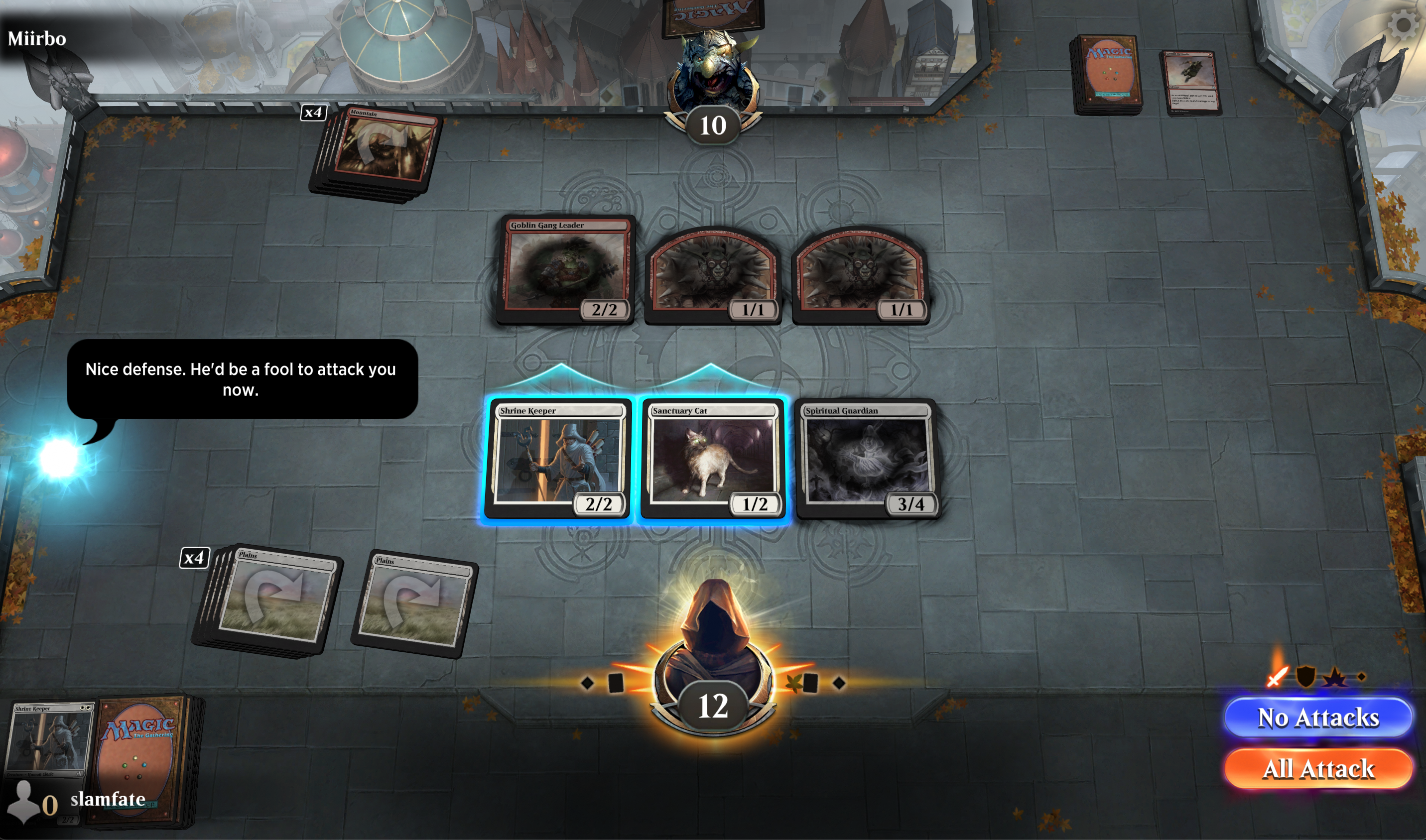
MTG Arena is the newest and most popular digital client for Magic: The Gathering, having largely replaced the original Magic: The Gathering Online (which is still available to play, but slightly archaic compared to Arena, and much less user-friendly). It’s free to download on Windows, macOS, and mobile.
When you create your account on Arena, you’ll go through a five round tutorial, where you’ll learn about some of the basic rules and mechanics of the game. After defeating the final boss (a malevolent draconic Planeswalker known as Nicol Bolas, who’s a regular character in the game), you’ll move on to the “Color Challenge.” Here, you’ll get the chance to try out five different pre-built decks–one of each color–and will be rewarded with new cards to update your decks with every time you win. This a great (and free!) way to get a head start on building up your digital collection.
From here, there are any number of ways to play on Arena–from Drafts, to Standard, to regularly updated special events and tournaments. It’s a great way to familiarize yourself with the rules of the game and by far the easiest way to play Magic in 2023.
Tabletop
Arena might take the cake in terms of convenience, but there’s still nothing quite like live, paper play. It’s the “gathering” part of Magic: The Gathering.
The best way to play in-person is at your local game store, or “LGS.” Here, you’ll find all sorts of events–casual Commander nights, Prereleases, high-stakes tournaments, and more. It’s a great way to meet other players, learn the ropes, and support local businesses all at once. Check out Wizards of the Coast’s store locator to find the closest shop to you.
Resources
Now that you know the basics, it’s time to start playing! Check out the links below for some further reading and information. Good luck, and have fun!
- Limited Resources–the most popular Magic podcast, hosted by hall-of-famer Luis Scott Vargas and longtime Magic commentator Marshall Sutcliffe. They focus mainly on Limited play, but frequently touch on the fundamentals of the game, as well.
- “Level One: The Full Course”–this series of articles, written by Magic pro Reid Duke, is, as it promises, a full-course on Magic strategy. It’s a deep dive, but once you have the fundamentals down, it’s a great place to look to level up your game.
- Feeling confident and ready to compete at the highest level? It won’t be easy, but anyone can do it. Check out Wizards of the Coast’s guide to getting there right here.
The products discussed here were independently chosen by our editors.
GameSpot may get a share of the revenue if you buy anything featured on our site.